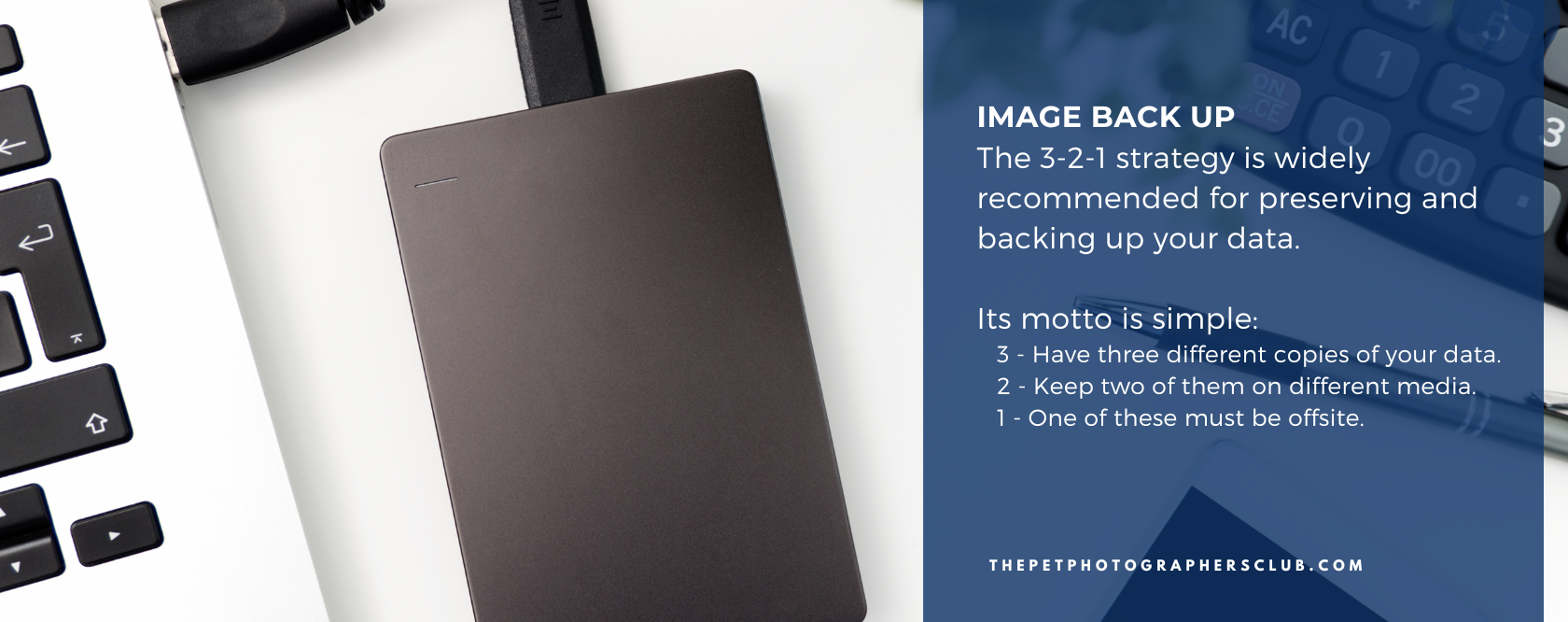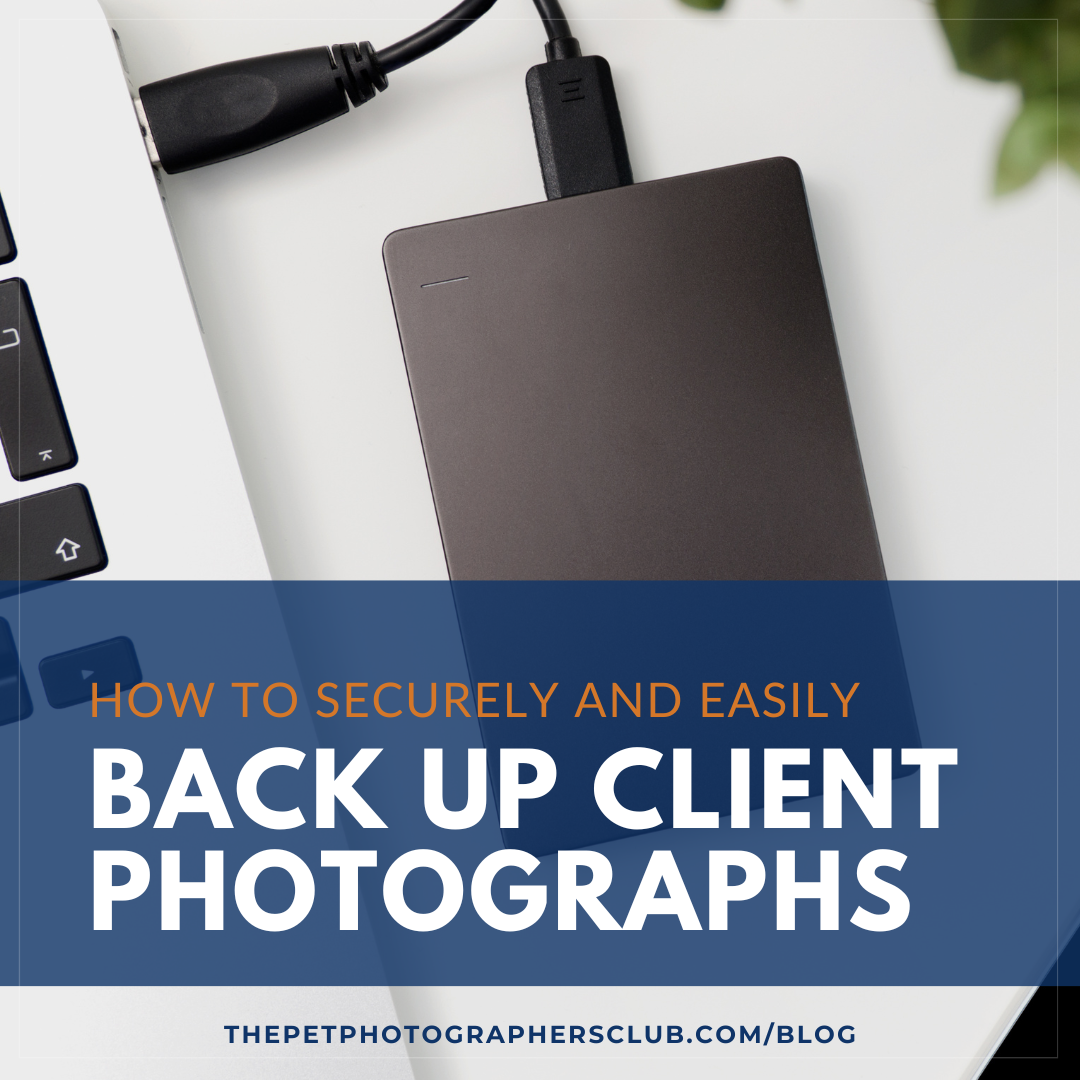How to securely and easily back up client photographs in 2023
If you hang out in any Facebook group for long enough, you’ll soon see a desperate post of someone asking how to retrieve lost images from a corrupted drive. But that same person will never ask twice because, we learn the lesson. And I say “we”, because I’ve been there.
I had been in business just a few short months. I had my first ever $2k+ sale, and then another a few days later. Both clients' images were sitting on a corrupted drive, without a backup. And to make matters worse- one of the dogs was a senior, deteriorating fast leaving no option for a reshoot.
The only other copy I had of those images were tiny web-resolution files on my iPad from the sales session (this was a decade ago- quality wasn’t like now!). Somehow, my lab worked a miracle and managed to print both clients orders, with just a few changes.
From that day on, I always made sure I had a proper back up system in place, and today, I want to make sure that you avoid the embarrassment and stress that I went through.
This guide looks to give you easy insight into how you can preserve those crucial photos. Whether these are photos of your client’s pets, or your own - the below will help you understand how to properly and easily store your images.
What leads to lost client photos?
Firstly, it’s important to understand what can lead to photos becoming lost. Below are just a few examples.
Improper device removal - It sounds patronizing, but when you connect a device to your computer, you need to remove it safely. Unplugging a storage device prematurely can lead to incomplete data transfers.
Corrupted or inaccessible devices - While there is no easy answer as to why devices or memory cards can become corrupted, or why computers sometimes can’t read them, sadly, it happens. Therefore, any files you may have stored on this media can potentially be at risk.
Damage to devices - Unfortunately, devices like computers and hard drives can become damaged, either by exposure to heat or water or simply after years of wear and tear. One day a device may be too damaged to use again.
Theft threats - It’s an obvious reason why people often lose access to their photos. Computers, digital cameras and large storage devices are, regrettably, prime targets for thieves or burglars.
Cyber hacks, viruses or malware - Criminals aren’t always visible, and are often lurking in the depths of networks, systems or infrastructure. Without adequate protection to detect intrusion, sensitive information can be quickly compromised, and you could potentially lose access to data, and even to the device itself.
Accidental formatting or deletion - Human error is commonplace, even when we’re trying to be super careful. Fingers can slip and keys can be pressed accidentally, often leading to photos ending up in places we never intended them to be.
There is a huge misconception that once a photo is deleted, it cannot be retrieved or recovered. This is not true - you can recover photos if they go missing. In fact, there is always a chance that they may well be in your computer’s Recycle Bin. If not, you may need to consider photo recovery software to bring your photos back.
However, if you want to save yourself the potential worry, consider storing and backing up your photos using the below method.
The 3-2-1 strategy
The 3-2-1 strategy is widely recommended for preserving and backing up your data.
Its motto is simple:
3 - Have three different copies of your data.
2 - Keep two of them on different media.
1 - One of these must be offsite.
Once you establish a backup strategy, it’s easy to get into the habit of backing up your photos, or, before long, it just happens naturally.
Best ways to back up your client photo sessions
So what different backup methods are there and which one should you choose? There is no ‘one-size-fits-all’ solution - you need to consider several choices before you decide on the right one for you.
Ultimately, it has to suit your workflow and lifestyle - for example, for those of you who are full-time professional pet photographers taking a lot of high-res photographs each session, we require ample storage space and multiple SD cards. Whereas those of you who are shooting once or twice a month, may not need to invest in such an array of drives with terabytes of storage space.
Whatever your preference, the following types of photo backup solutions can work wonders at preserving your images.
External hard drives
Solid State Drive (SSD) - External SSD drives use flash storage technology, which uses memory chips to store data as opposed to HDD drives. These drives are, therefore, faster to respond due to having no additional moving parts, while also using less power. Despite this, SSD drive prices are often much higher than HDDs, with users expected to pay more per GB of storage.
Hard Disk Drive (HDD) - External HDD drives can work seamlessly alongside a computer’s integrated hard drive, which can often become filled up quickly. These devices offer large amounts of storage space and are quite affordable. However, these devices use moving disks and thus are more prone to damage from bumps, scratches, and wear and tear.
Universal Serial Bus (USB) - These flash drives are highly portable and might be great for temporary measures but aren’t typically recommended for professionals even though they are sturdy since they don’t contain any moving parts inside that can wear out or break. The problem is that they are often lost due to their small size, and finding higher than 128GB of storage space on a USB flash drive is often harder to come by.
Cloud storage solutions
Saving photos to a photo cloud storage platform is ideal for those that want simplicity and the least amount of hassle. You can save photos to the cloud using platforms like Dropbox, Microsoft OneDrive, Apple iCloud and Google Photos.
While these storage programs have respectable amounts of space for free account holders, the true long-term benefits will only come with paid memberships that bill per month. It varies between providers and what your storage needs are. For the budget-conscious, you may need to think carefully about which one you can feasibly afford.
A combination
Many external hard drives also come with an online storage option which is what we recommend you look into. For example the Seagate Backup Plus comes with extra OneDrive Cloud storage and WD’s My Cloud Mirror is an even more robust solution to consider.
The right backup strategy for your business
The most significant challenge when backing up your photos is deciding which one meets your needs best.
Leaving your work on a single device; your computer, laptop or a drive is simply putting all your eggs in one basket. While there is every possibility that your device won’t be compromised, nothing is ever guaranteed to be safe, 100% of the time.
Using a combination of external drives and cloud storage will be the safest way to keep your client image safe (the more places-the better!), however, using a single form of backup is better than using none whatsoever.
What about you? Which options are you using to ensure your clients pet photography is backed up?
Members continue the discussion in the Mastermind Facebook Group, otherwise shoot me an email: kirstie@thepetphotographersclub.com
Author
Kirstie McConnell |
Founder
The Pet Photographers Club
When Kirstie launched her pet photography business in Australia in 2012, the genre was barely a thing. She spent the next years at the forefront of this niche, marketing not just her own business, but the concept of pet photography. Each year she photographed around 100 dogs, cats and horses per year to create wall art and albums for pet-parents.
Now based in Italy, she continues to offer pet photography to her clients back in Australia on return trips, but otherwise spends her energy helping other pet photographers build a business which will allow them to follow their dreams.
Internationally recognized as a leader in the industry, she hosts the podcast, workshops, courses and business events for The Pet Photographers Club which she co-founded.
I recently presented a class “Setup for Success and Profit Fast as a Pet Photographer” for Photobizx. The replay is now available to purchase, and if you grab it this week, you’ll save 50%!
There weren’t any courses like this when I started. It was all trial and error for me, but once I worked out...
Which treats are the best
The basics on how to read dog language
What kind of leash will help make retouching faster
And of course, who to target for marketing, why and how
WHICH WILL ALL BE COVERED IN THIS TRAINING
My shoots went from 3 hours to 40 minutes!
Retouching from days to minutes.
And sales from hundreds to thousands.
This course is about skipping the trial and error, and getting straight to the profits.
Pin to Pinterest!




